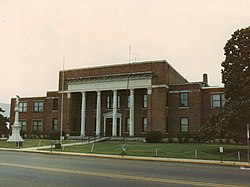Neshoba County, Mississippi | |
|---|---|
 Neshoba County Courthouse and Confederate Monument in Philadelphia | |
 Location within the U.S. state of Mississippi | |
 Mississippi's location within the U.S. | |
| Coordinates: 32°45′N89°07′W / 32.75°N 89.12°W | |
| Country | |
| State | |
| Founded | 1833 |
| Named after | Choctaw for “wolf” |
| Seat | Philadelphia |
| Largest city | Philadelphia |
| Area | |
• Total | 572 sq mi (1,480 km2) |
| • Land | 570 sq mi (1,500 km2) |
| • Water | 1.5 sq mi (3.9 km2) 0.3% |
| Population (2020) | |
• Total | 29,087 |
| • Density | 51/sq mi (20/km2) |
| Time zone | UTC−6 (Central) |
| • Summer (DST) | UTC−5 (CDT) |
| Congressional district | 3rd |
| Website | www |
Neshoba County is a county located in the central part of the U.S. state of Mississippi. As of the 2020 census, the population was 29,087. [1] Its county seat is Philadelphia. [2]
Contents
- History
- Late 19th century to present
- Geography
- Major highways
- Adjacent counties
- Demographics
- 2020 census
- 2000 census
- Communities
- City
- Town
- Census-designated places
- Unincorporated communities
- Politics
- Education
- See also
- Footnotes
- Further reading
- External links
The county is known for the Neshoba County Fair and harness horse races. It is home of the Williams Brothers Store, which has been in operation since the early 1900s.
In June 1964, civil rights workers James Chaney, Andrew Goodman, and Michael Schwerner were chased down, tortured, and murdered by members of the Ku Klux Klan. They were buried in an earthen dam on private property off Highway 21; Goodman was still alive. [3] Initially treated as a missing persons case, their disappearance provoked national outrage and contributed significantly to the July enactment of the Civil Rights Act by President Johnson. [4]
The Mississippi Band of Choctaw Indians (MBCI), a federally recognized tribe, is based here and has developed one of the largest casino complexes in the state on their reservation, the Pearl River Resort.
